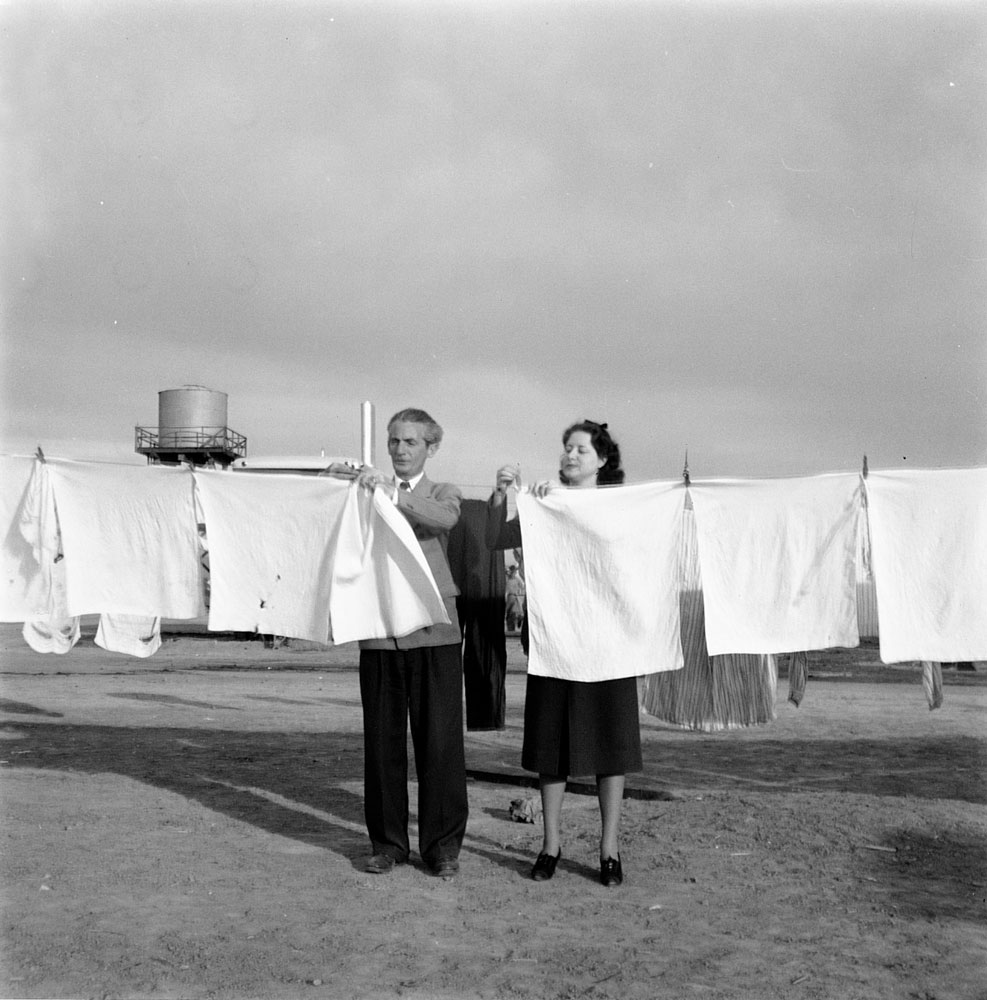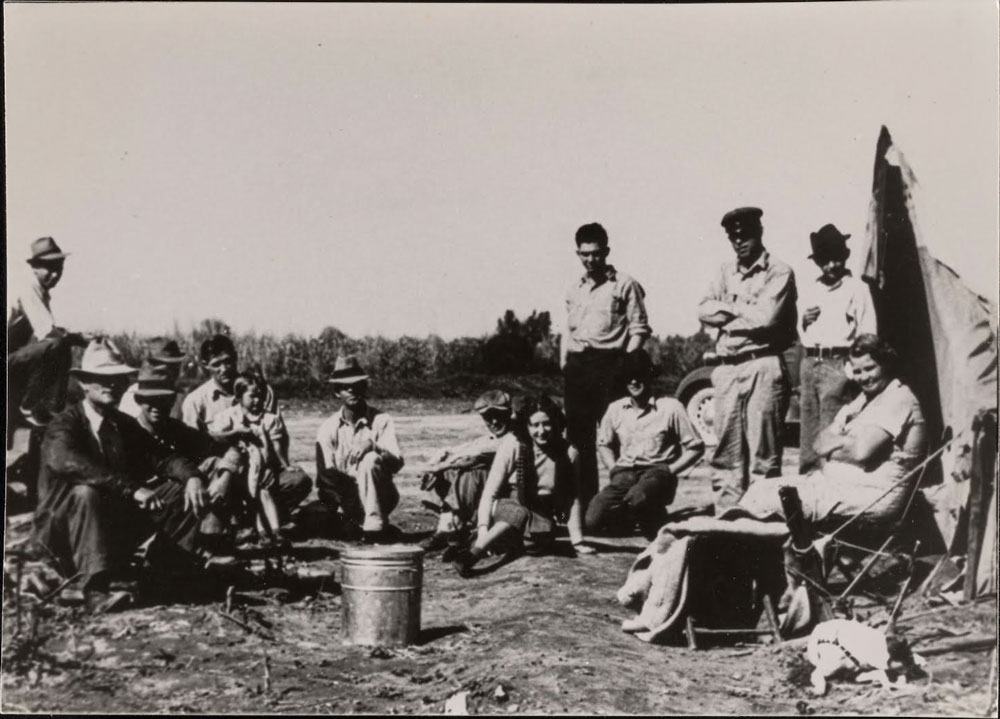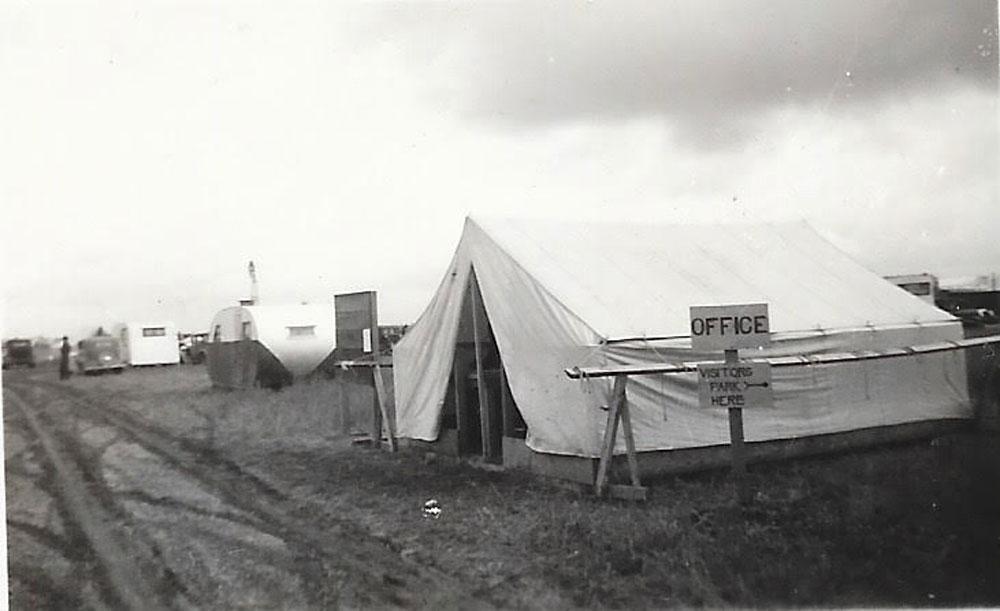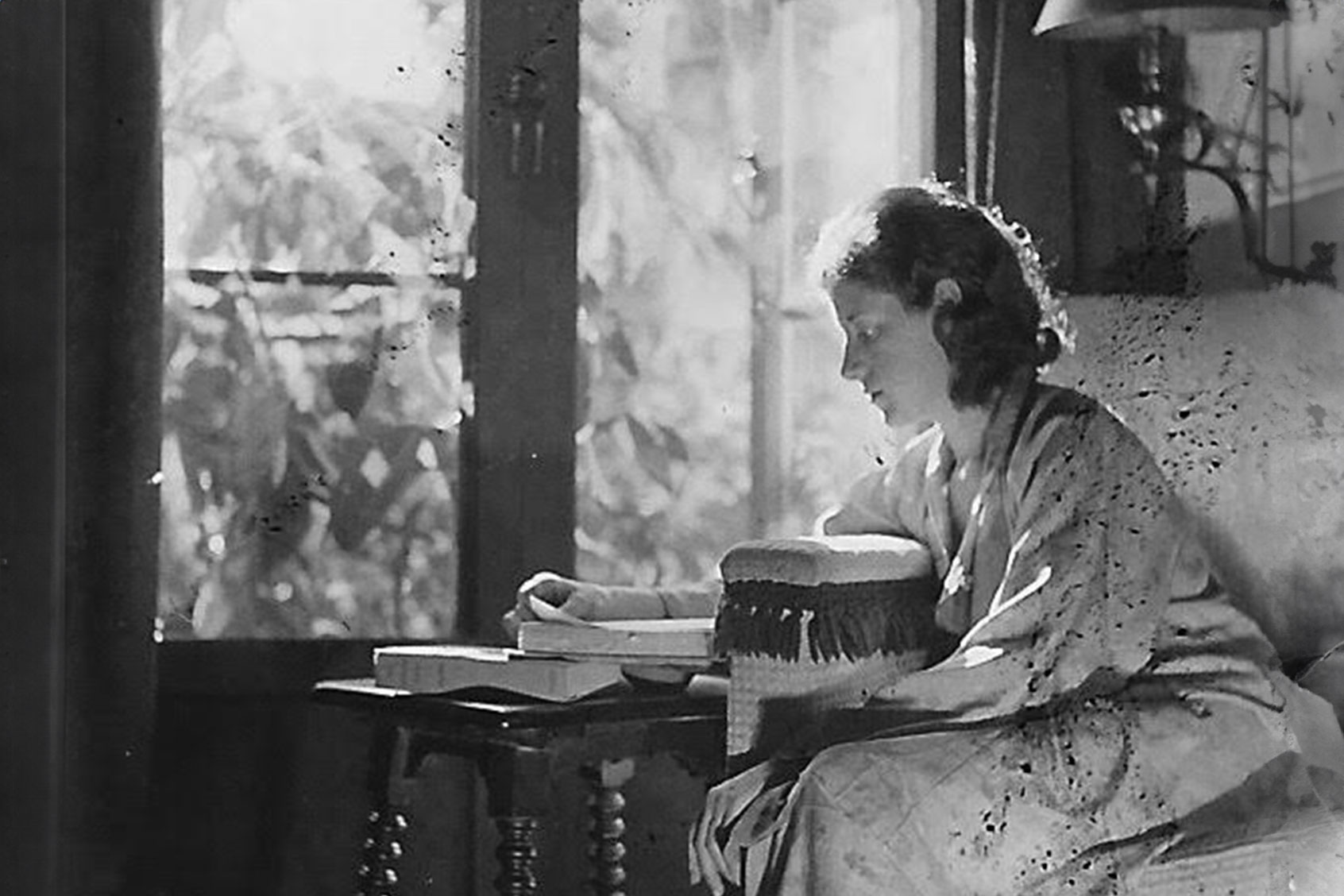Sanora Babb, who grew up in a dugout farming broomcorn in eastern Colorado, understood what it was like to grow up in poverty. That’s why she was drawn to write about the plight of the hundreds of thousands of migrants who were making their way to California in order to try and find work. In 1935, she began working for Tom Collins with the Farm Security Administration (FSA) at the migrant refugee camps and taking extensive notes for a novel she had begun about the plight of the migrants.
A few months into Babb’s job volunteering for the FSA, Tom Collins invited Babb to a nearby café to have lunch with a writer he was collaborating with named John Steinbeck. Steinbeck, who had just published a bestselling novel, "Of Mice and Men," in February 1937, had found Collins while he was writing a series of articles on the plight of the Dust Bowl refugees for The San Francisco News which were published from October 5 to 12, 1936. In addition to writing those seven articles for The News, Steinbeck had also written a short summary about the migrant situation that appeared in The Nation in mid-September 1936, and a pamphlet entitled “Their Blood Is Strong,” published by the Simon J. Lubin Society. Thinking that having a bestselling writer bring attention to the struggling camps would be beneficial, Collins agreed to accompany Steinbeck as he visited the camps. Steinbeck had been so overwhelmed the first time he accompanied Collins and saw the absolute poverty that the migrants had to suffer he told Collins, “By god! I can’t stand anymore! I’m going away and blow the lid off this place.”
Steinbeck had again visited Collins for a few days in mid-October 1937. When the writer returned home, he began working on his first attempt at writing his Dust Bowl novel, a manuscript he called “The Oklahomans,” but by January 1938 he’d abandoned this manuscript altogether and started his second attempt, “L’Affaire Lettuceberg.” In this second version (begun in February and finished in May 1938), Steinbeck’s focus shifted from writing about the refugees to mocking the growers but by the time he finished it he was so disheartened by it that he destroyed the manuscript before his agent (who was already marketing the book) had seen it.
 Sanora Babb and Tom Collins at the Arvin Camp near Bakersfield, CA. (Courtesy of Joanne Dearcopp, literary executor of the Babb estate)
Sanora Babb and Tom Collins at the Arvin Camp near Bakersfield, CA. (Courtesy of Joanne Dearcopp, literary executor of the Babb estate)
Collins was thrilled that Steinbeck was writing a novel and hoped he might bring attention to the desperate issues faced by the refugees. As Collins wrote in his own unpublished memoir, “Bringing in the Sheaves,” he pleaded with Steinbeck to write about what he had witnessed: “What you want to do, John, is to keep your impressions in your mind and when the time is ripe DO something about those conditions. If you fail to do that then you are letting those thousands of people down.” During Steinbeck’s visits, none of the migrants knew they were being observed by a famous writer who intended to document their experiences, as Steinbeck used a fictitious name while he was in the camps. According to Jackson Benson’s biography of Steinbeck, the writer hid his identity while he was with Collins because he was afraid of retaliation by the Associated Farmers and other growers’ organizations. As Steinbeck wrote in his 1938 diary,
I’ve written an article about starvation in the valleys . . . must be careful. Must not get angry. I know perfectly well the danger I am running in exploring the Associated Farmers. They are quite capable of murder or faking a criminal charge I know they can hurt me personally but they may not be able to beat the thing I can start.
Little did Babb know that the copy of her field notes she would willingly give Steinbeck would not only inspire him as he began his third and final attempt at writing his Dust Bowl novel, but would also make the publishing of her own novel impossible.
However, Steinbeck did not hide his identity from Babb. It was during Steinbeck’s May 1938 visit with Collins, after he’d abandoned two versions of the book he wanted to write, that he met Babb. That sunny day, as Babb walked into the café, the rainy season had subsided and the earth was throbbing with the possibility of new crops and jobs for the workers. Over cups of coffee, they talked about the camps, the refugees’ plight, the terrible control the Associated Farmers held over the communities where they lived, and the powerful political lobby of farm owners. Little did Babb know that the copy of her field notes she would willingly give Steinbeck would not only inspire him as he began his third and final attempt at writing his Dust Bowl novel, but would also make the publishing of her own novel impossible. As she later reflected, “Tom Collins . . . had asked me to keep detailed notes of our work every day, of the people, things they said, did, suffered, worked. I thought it was for our work, or for him, but it was for Steinbeck”; and “Tom asked me to give him my notes. I did. Naïve me.”
Meanwhile, Bennett Cerf at Random House was impressed with the four chapters of her would-be debut novel that Babb had sent him, so much so that he invited her to New York to finish writing her novel and offered her a book contract to go with it.
The refugees Babb met at the camps were not all poor, uneducated “Okies,” and the people she introduces us to in her novel are varied and real. She kept the title she had originally chosen — "Whose Names Are Unknown" — which was based on an eviction notice she had seen on a decrepit worker’s shack on a corporate farm, a notice that read “To John Doe and Mary Doe whose true names are unknown.” Babb thought this title embodied the fact that to the big-business corporate farmers in California, the migrant workers who toiled for pennies a day were nameless. And to the local citizens who blocked the migrant workers’ children from going to school, the children were nameless. And to the hospitals that would not admit migrant women who were suffering difficult births and instead sent these women back to the dirt floors of their tents to deliver their babies on newspapers, these mothers and infants were nameless. In her monumental novel, Babb endeavored to give these people back their names. More importantly, she recorded a version of Dust Bowl history that gives agency to its victims and highlights the diversity found in California in the 1930s.
Babb’s narrative depiction of life in the camp is both personal and inclusive. She uses a lyric, free associative voice to accurately depict the dislocation caused by hunger: “Lonnie sleeping Friday weeds carrots three feet wide a woman screaming quarter of a mile tomorrow surplus commodities walking music water running forgetting forty cents a day sleeping forgetting forty cents floating like air clear water running sparkling through the brain surplus brain commodities sleeping a feather of music tickling this is my tent sitting down like a cloud floating music faces fluffy sound in my ears flying away” (italics in the original).
 Sanora Babb with a large group of the people she worked with at the FSA camps. (Courtesy of Joanne Dearcopp, literary executor of the Babb estate)
Sanora Babb with a large group of the people she worked with at the FSA camps. (Courtesy of Joanne Dearcopp, literary executor of the Babb estate)
Babb also uses her experiences working at the camps to accurately depict what it was like to have to give birth to an already starving child in a dirt-floored tent. When the mother is unable to produce milk, she depicts how fellow campers rally to gather enough money to pay for milk, but not in time to save the child: “‘That baby don’t need no milk. He’s dead.’ One of the women sighed. ‘He’s better off,’ she said. ‘It starved to death before it ever saw the light of day.’” But her depiction of women is not just as passive victims. In Babb’s novel, women stand up against the atrocities they are faced with, and they make it known that they work as hard as men.
Babb also uses her experiences working at the camps to accurately depict what it was like to have to give birth to an already starving child in a dirt-floored tent.
When Babb set out to write this novel, she did so with the intent to not only depict the truth of what she saw, but also to offer an idea towards a solution. In Babb’s mind, this solution had everything to do with the community she’d witnessed. She believed that the only way for her characters to overcome the horrible circumstances that had befallen them was to band together and fight the giant corporate farms that were overtaking the agricultural industry.
As scholar Christopher Bowman has pointed out, “While both Babb’s and Steinbeck’s books were “motivated by a genuine concern for the Dust Bowl migrants, and both approached their novels as projects with which they could cultivate public support” for the migrants in California, the story of Steinbeck’s book is quite different. After his two previous starts to the novel in late May 1938, Steinbeck began rapidly writing what would become the iconic book about the Dust Bowl: "The Grapes of Wrath." He wrote it fast, completing his first draft by mid-October. As biographer Jackson Benson observed, “When at last he did get into the writing of the final draft of the 'Grapes of Wrath,' he made it a long sprint, rather than a marathon run, and the strain nearly destroyed him.” Indeed, Steinbeck would be hospitalized for exhaustion after finishing the first draft of the book.
On September 3, Steinbeck’s wife Carol came up with the title “The Grapes of Wrath,” an allusion to Revelations 14:19–20 and a verse from “Battle Hymn of the Republic” by Julia Ward Howe. Carol Steinbeck would also help her husband by not only typing the drafts as he wrote them but with “writing the revision, that is, correcting errors and editing for contradictions and awkwardness.” It’s because of her deep involvement in the creation of the book that Steinbeck thought of the book as his wife’s novel and why he also dedicated the book “To Carol, who willed this book.”
Perhaps due to this breakneck speed and his lack of knowledge about the affected area, Steinbeck made serious mistakes and omissions that numerous scholars have thoroughly documented.
For example, Steinbeck placed his main characters, the Joads, who’d been “tractored out” by their corporate landlords, first in Shawnee County and then in Sallisaw, Oklahoma, both of which are far from the panhandle and outside of the areas deeply affected by the Dust Bowl. According to Benson, Steinbeck did travel to Oklahoma briefly in 1937, making a car trip from Chicago on Route 66 with his wife, but with little intent to do research.
The Steinbecks purchased a red Chevrolet in New York . . . and started home, stopping by Chicago They continued their trip, following Route 66 through Oklahoma, but according to Carol, John made no conscious effort to do any research for his book along the way.”
Not only would he not do research on this trip, he would also lie about a second trip. According to Benson, Steinbeck would later encourage a false claim that in February 1938, he “followed a trail of migrants from Oklahoma to California and lived with them in roadside camps” when he was researching the book with Tom Collins. That trip never took place.
In addition to the error in setting, Steinbeck’s book made it seem as if the only people who were affected by the Dust Bowl were poor white farmers. As Benson points out, “The family Steinbeck was writing about was actually a composite of several families he had encountered in visiting one squatters’ camp after another.” Steinbeck had only met the people he based his characters on briefly, and this distance shows in his characterization of them. We see little of their interior dialogue and most of them remain stereotypes. Steinbeck’s novel doesn’t linger for very long in Oklahoma. When the story begins, the disaster has already occurred; the Joads have lost their land. Therefore, his characters’ relationship to the land is never established. Nor does his novel elaborate on the horrific effect the greatest natural disaster in the United States had on the people who were living in “No Man’s Land.” Instead, his story focuses on what happened after a handful of the 650,000 Dust Bowl refugees left their homes and everything they knew and arrived in California. Because of this, "Grapes of Wrath" readers don’t witness the slow terror of the natural disaster as it affected people in their homes in Oklahoma and Colorado and surrounding states, and how it left them little choice but to flee or starve.
For the source material of "Grapes of Wrath," Steinbeck would heavily rely on the FSA field notes written by Collins and Babb.
For the source material of "Grapes of Wrath," Steinbeck would heavily rely on the FSA field notes written by Collins and Babb. Steinbeck noted using “great gobs of information” from Babb’s and Collins’s reports and notes, and from Collins’s subsequent letters. As he recorded in the journal he kept while writing the book, “Letter from Tom with vital information to be used later. He is good. I need this stuff. It is exact and just the thing that will be used against me if I am wrong.” Steinbeck was “particularly worried about a conspiracy designed to discredit him” by the Associated Farmers or other growers’ organizations.
Babb continued to work at the camps until late October or November, when she returned home to work on her book and reunite with her sister and partner, James Wong Howe. But she soon realized that to finish her book, she needed the time and space to write. So the following spring, she took the train to New York City to finish her manuscript while living on the Upper West Side with her friend the dancer Lotte Goslaar. She loved living in New York City and knowing her first book was nearing completion. The early summer was boiling hot, but she sat at her desk and diligently completed editing her book and turned it in to Bennett Cerf, her editor at Random House.
Cerf wrote to Babb on July 27, 1939, to say the first reader’s report on "Whose Names Are Unknown" had come back “exceptionally fine” and told her that he wanted to “read it myself.” He promised to get back to Babb within a week.
Her publishing contract for "Whose Names Are Unknown" had been canceled — due to the wide success of Steinbeck’s new book.
However, a week later, when Cerf invited her to the Random House offices to meet with him, she faced a situation she could never have expected. When she entered his office, he was seated formally at his desk, which was cleared of everything except “a check under his hands.” She knew right away that something had gone wrong. Though the reading reports about her book had been extremely positive, Cerf explained to Babb that her publishing contract for "Whose Names Are Unknown" had been canceled — due to the wide success of Steinbeck’s new book, "The Grapes of Wrath." By June 1939, "The Grapes of Wrath" had sold over 200,000 copies, and film rights to the book had been sold for $75,000. Steinbeck’s fame, which had already been solidified by his bestselling 1937 novel "Of Mice and Men," was skyrocketing. Babb was speechless and left Cerf’s office in utter and complete shock.
The two reader’s reports about Babb’s book had the same complaints that “it would almost seem as if Sanora Babb and John Steinbeck had thoroughly discussed an identical theme and set out to write their separate books—so similar are GOW ["The Grapes of Wrath"] and WNAU ["Whose Names Are Unknown"].” They go on to explain Babb’s approach: “The plight of these people is described with great understanding that indicates personal experience. Whereas Grapes had color, excitement and humor, Babb’s book is more uniformly intense, more a piece of the drabness of her people.” What’s heartbreaking is how this reviewer closes the report: “If there hadn’t been a Grapes, I would say unreservedly, here is something new, something fine, we must publish. Moreover, an unusual talent is displayed in this first novel.”
 Babb's office tent where she wrote her novel, Whose Names Are Unknown. (Courtesy of Joanne Dearcopp, literary executor of the Babb estate)
Babb's office tent where she wrote her novel, Whose Names Are Unknown. (Courtesy of Joanne Dearcopp, literary executor of the Babb estate)
In subsequent letters, Cerf, who acknowledged the craft of Babb’s novel but couldn’t see his way to publishing two books about the same event, advised Babb to put her manuscript away for a few years until the market might be more receptive to another novel about the Dust Bowl. As he wrote to her in a letter on August 16, 1939:
After viewing the matter from every angle and discussing it in a full editorial conference for an hour, I don’t see how in God’s green earth we can publish “Whose Names Are Unknown.” What rotten luck for you that “The Grapes of Wrath” should not only have come out be- fore your book was submitted but should have so swept the country! Obviously, another book at this time about exactly the same subject would be a sad anticlimax! And I think that you must face the fact just as we did here. The last third of your book is so completely like “The Grapes of Wrath” that the families and characters might basically be interchanged in the two.
* * *
Although she had contributed some of the material Steinbeck used, he never acknowledged Babb’s assistance.
Though Steinbeck met Babb on at least one occasion when he was traveling with his friend Collins doing research for his book, he never acknowledged her input into his work. His second dedication in "Grapes of Wrath" (after “to Carol who willed it”) — “To TOM who lived it” — only acknowledges the influence of Collins as a “chief source, guide, discussant, and chronicler of accurate migrant information.” He even gave Collins a real-life prototype in the character of Jim Rawley, the manager of the “Weedpatch” government camp (which is based on the Arvin camp). Although she had contributed some of the material Steinbeck used, he never acknowledged Babb’s assistance. Given Steinbeck’s use of his wife’s labor on "The Grapes of Wrath" without acknowledgment beyond a dedication, it’s likely that Steinbeck didn’t think it necessary to give Babb credit for the work she was doing (in his mind, her labor—female labor—was being done for Collins, and therefore her work belonged to Collins). It’s also likely that Steinbeck didn’t know about Babb’s novel. "Whose Names Are Unknown" was not published in any form, except short excerpts in small magazines, before Steinbeck’s death on December 20, 1968, and there are no references to it or to Babb in Steinbeck’s archives. Given his fame, it is also likely that when Babb met him at the camps, she didn’t tell him about her own novel-in-progress, or that if she did, he didn’t pay her or her work much notice.
* * *
Once "Whose Names Are Unknown" was published by the University of Oklahoma Press, the fact that Steinbeck had borrowed from Babb’s notes slowly began to circulate. After reading Babb’s novel, some Steinbeck scholars, like Michael J. Meyer, began to substantiate the merit of the claims that Steinbeck had appropriated Babb’s material. In his review of "Whose Names Are Unknown" for the Steinbeck Review, Meyer points out that Steinbeck called himself “a shameless magpie” and was “accused of borrowing the stories that comprise 'Pastures of Heaven' from Beth Ingalls” as well as “the ideas of Edith Wagner for his short story ‘How Edith McGillicuddy Met Robert Louis Stevenson.’”
Meyer carefully listed the similarities he discovered between the two texts, publishing a catalog of his findings in the article. He pointed out similarities between Babb’s descriptions of still-born babies as being “all dried up; even his tongue is dry” and like “a little old man,” and Steinbeck’s character Rosasharn’s stillborn being described as a “shriveled little mummy” that “never breathed” and “never was alive.” Or the overlapping scenes of the company store charging “exorbitant prices” in both texts; how both books create a contrast of the fertile fields against the dying migrants; or how in each novel there is an “emphasis on music as an encouragement for the human spirit.” He compares “the detailed description of nature that begins chapter 38 of 'Whose Names Are Unknown' with that of chapter 1 of 'The Grapes of Wrath,' along with the way both authors depict “the generosity and compassion of some humans, the disdain of the Okies for charity,” and in addition, how both texts show the horrendous effect being called an “Okie” had on the characters. He points out how both authors use a metaphor (Babb an insect, Steinbeck a land turtle) to symbolize the migrants and how they “are being toyed with by a higher, invulnerable power.” At the end of his article, Meyer urged his fellow Steinbeck scholars to “read Babb—if only to see for themselves the echoes of 'Grapes' that abound in her prose.”
Then, in 2007, Babb’s notes, which she had donated to the Harry Ransom Center at the University of Texas at Austin, became public through the scholarship of Doug Wixson, who published "The Dirty Plate Trail: Remembering the Dust Bowl Refugee Camps." The book both published and contextualized the notes Babb took while she was working at the FSA camps with Tom Collins. When Meyer reviewed Wixson’s book in 2010 in the Steinbeck Review, he noted that “chapters 2, 3 and 4 reproduce much of Sanora Babb’s field notes from 193[8]. Of special interest to Steinbeck scholars is the fact that several of the reprinted entries reflect almost identical episodes in 'The Grapes of Wrath.'”
Read more
about literary history


